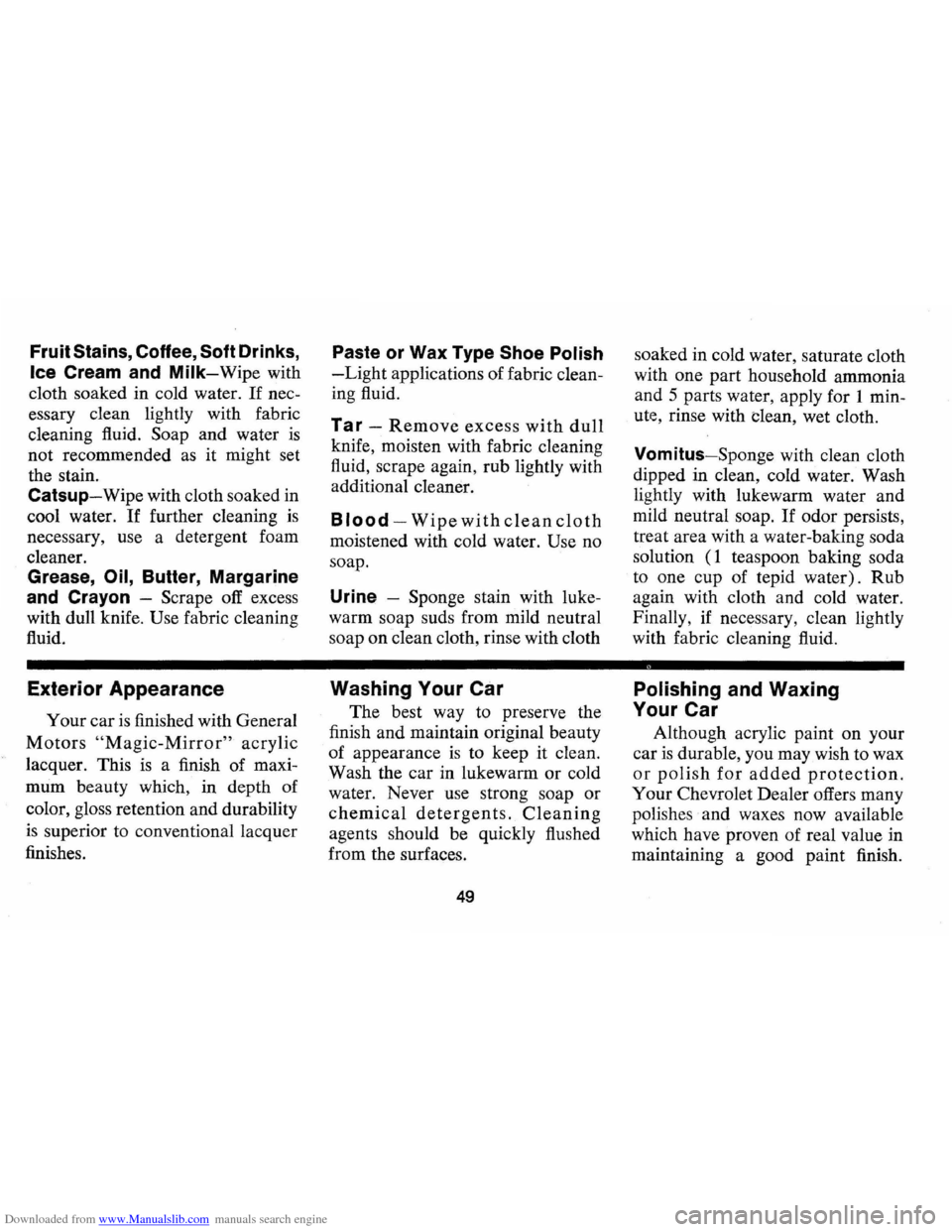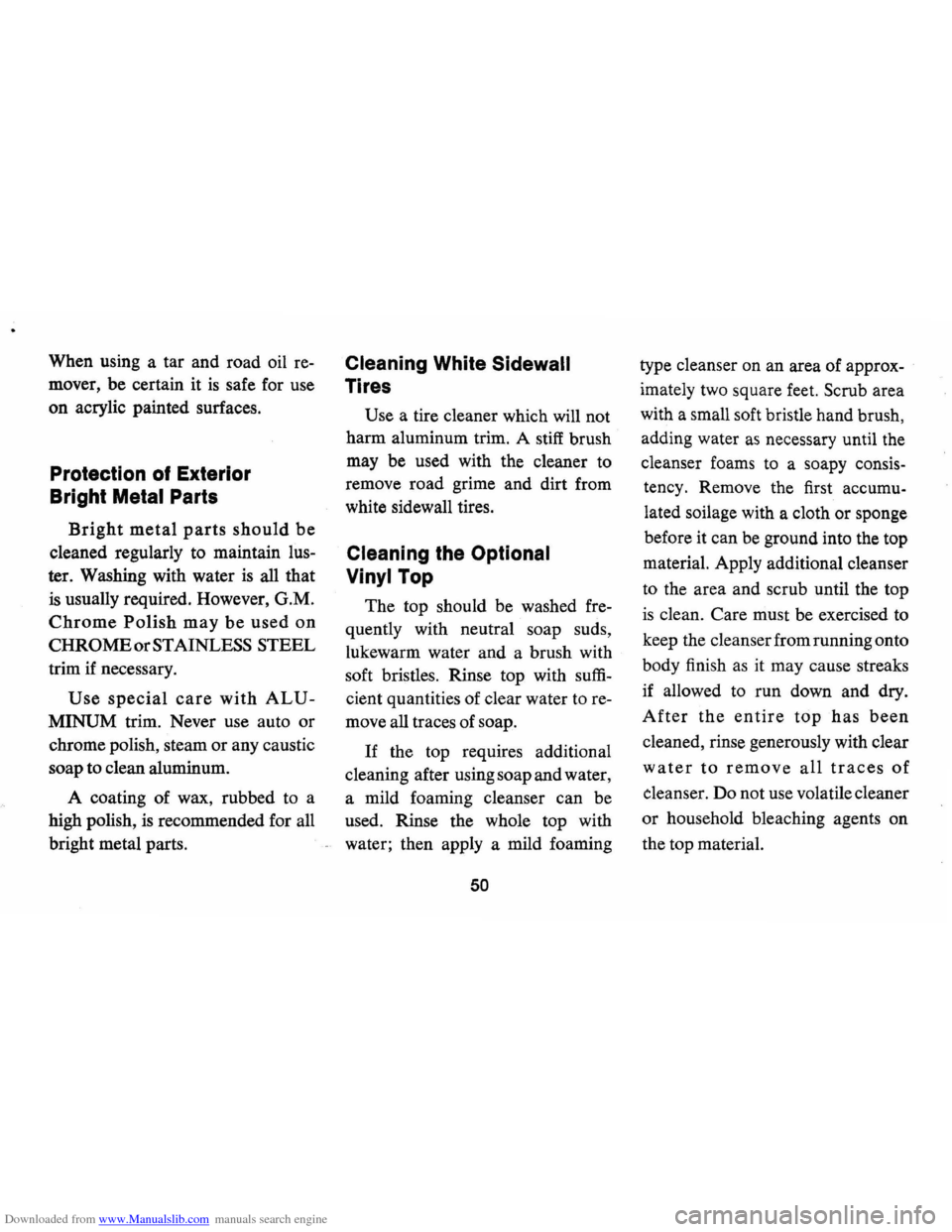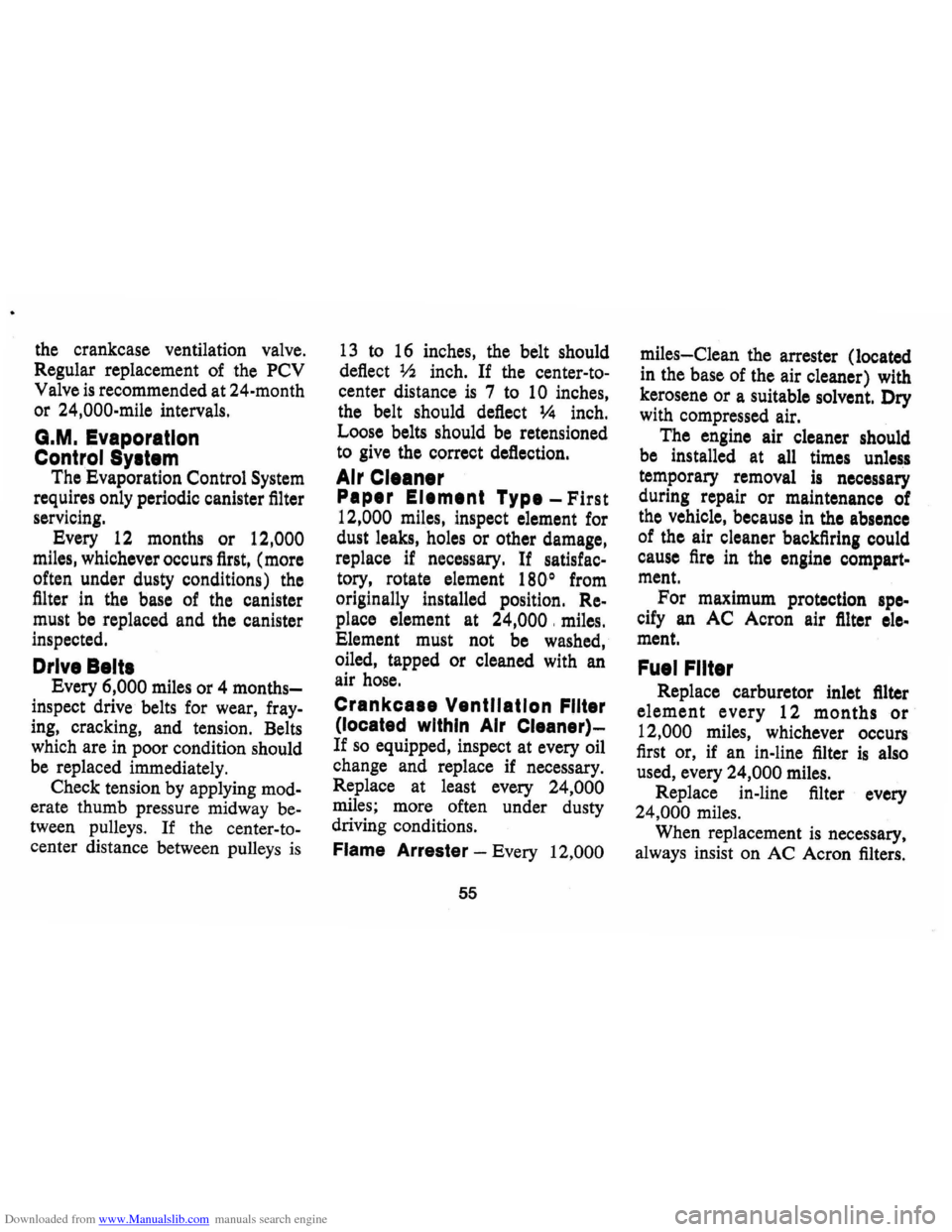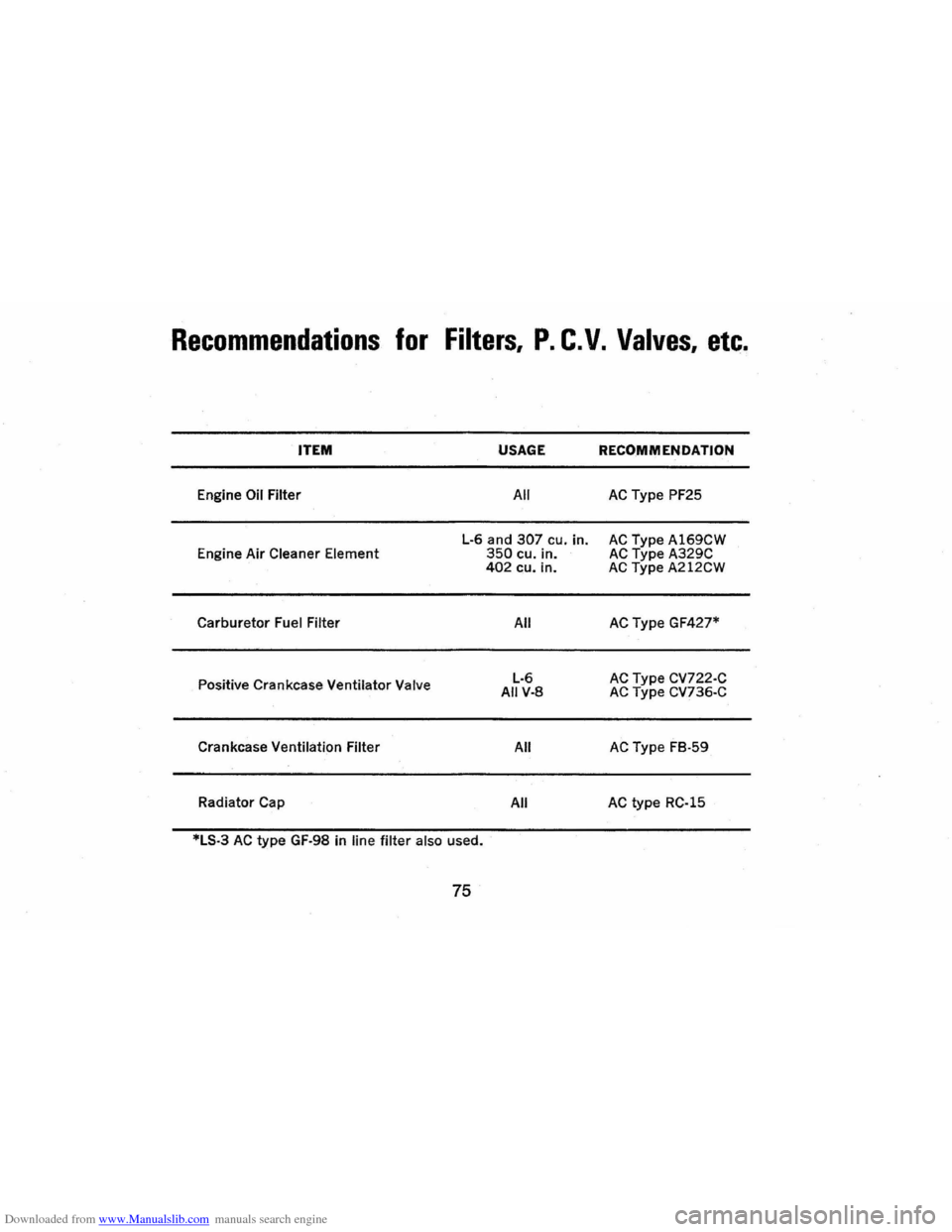1971 CHEVROLET CAMARO oil type
[x] Cancel search: oil typePage 50 of 88

Downloaded from www.Manualslib.com manuals search engine APPEARANCE CARE
Care and Cleaning
of Interior Soft Trim
Dust and loose dirt that accumu
late on interior fabric trim should
be removed frequently with a
vac
uum cleaner, whisk broom or soft
brush. Vinyl
or leather trim should
be wiped clean with a damp cloth.
Normal cleanable trim soilage,
spots or stains can be cleaned with
the proper use of trim cleaners
available through General Motors
dealers
or other reputable supply
outlets. Before attempting to
re
move spots or stains from uphol
stery, determine as accurately as
possible the nature and age of the
spot
or stain. Some spots or stains
can be removed satisfactorily with
water
or mild soap solution (refer
to accompanying
"Removal of Spe
cific Stains"). For best results, spots
or stains
should be removed
as soon as possible. Some types of
stains
or soilage such as lipsticks,
some inks, certain types of grease,
mustard, etc., are extremely
diffi
cult and, in some cases, impossible
to completely remove. When
clean
ing this type of stain or soilage, care
must be taken not to enlarge the
soiled area.
It is sometimes more
desirable to have a small stain than
an enlarged stain as a result of
care
less cleaning.
47
CAUTION: When cleaning Interior soft trim such as upholstery or carpeting, do
not use volatile cleaning solvents such
as: acetone, lacquer thinners, carbon tet
rachloride, enamel reducers, nail polish
removers; or such cleaning materials .s
laundry soaps, bleaches or reducing
agents (except as noted in the Instruc
tions on stain removal). Never use gaso
line or naphtha lor any cleaning purpose.
These
materl./s may be toxic or flam
mable, or may cause damage to Interior
trim.
Page 51 of 88

Downloaded from www.Manualslib.com manuals search engine Cleaning Fabrics with
Cleaning Fluid
This type of cleaner should be
used for cleaning stains containing
grease, oil
or fats. Excess stain
should be gently scraped off with
a clean dull knife
or scraper. Use
very little cleaner, light pressure,
and clean cloths (preferably cheese
cloths). Cleaning action with cloth
should be from outside of stain to
wards center and constantly chang
ing to a clean section of cloth.
When stain
is cleaned from fabric,
immediately wipe area briskly with
a clean absorbent towel
or cheese
cloth to help dry area and prevent
a cleaning ring.
If ring forms, im
mediately clean entire area
or panel
section of the trim assembly.
NOTE: Sometimes a difficult spot
may require a second application
of cleaning fluid followed immedi
ately by a soft brush to completely
remove the spot.
Cleaning Fabrics with
Detergent Foam
Cleaners
This type of cleaner is excellent
for cleaning general soilage from
fabrics and for cleaning a panel sec
tion where a minor cleaning ring
may be left from spot cleaning.
Vacuum area to remove excess
loose dirt. Always clean at least a
full trim panel
or section of trim.
Mask adjacent trim along stitch
or
weld lines. Mix detergent type foam
cleaners in strict accordance with
directions
on label of container.
Use foam only on a clean sponge or
48
soft bristle brush - Do not wet
fabric excessively or rub harshly
with brush. Wipe clean with a
slightly damp absorbent towel
or
cloth. Immediately after cleaning
fabric, dry fabric with a dry towel
or hair dryer. Rewipe fabric with
dry absorbent towel
or cloth to re
store the luster of the trim and to
eliminate any dried residue.
Removal of Specific Stains
Candy -Chocolate, use cloth
soaked in lukewarm water; other
than chocolate, use very hot water.
Dry.
If necessary, clean lightly with
fabric cleaning fluid.
Chewing Gum-Harden gum with
ice cube and scrape off with dull
knife. Moisten with fabric cleaning
fluid
and scrape again.
Page 52 of 88

Downloaded from www.Manualslib.com manuals search engine Fruit Stains, Coffee, Soft Drinks,
Ice Cream and Milk-Wipe with
cloth soaked in cold water.
If nec
essary clean lightly with fabric
cleaning fluid.
Soap and water is
not recommended as it might set
the stain.
Catsup-Wipe with cloth soaked in
cool water.
If further cleaning is
necessary, use a detergent foam
cleaner.
Grease, Oil, Butter, Margarine
and Crayon -
Scrape off excess
with dull knife.
Use fabric cleaning
fluid.
Exterior Appearance
Your car is finished with General
Motors "Magic-Mirror" acrylic
lacquer. This is a finish of maxi
mum beauty which, in depth of
color, gloss retention and durability
is superior to conventional lacquer
finishes.
Paste or Wax Type Shoe Polish
-Light applications of fabric clean
ing fluid.
Tar -Remove excess with dull
knife, moisten with fabric cleaning
fluid, scrape again, rub lightly with
additional cleaner.
Blood -Wipe with clean cloth
moistened with cold water. Use no
soap.
Urine -Sponge stain with luke
warm soap suds from mild neutral
soap on clean cloth, rinse with cloth
Washing Your Car
The best way to preserve the
finish and maintain original beauty
of appearance
is to keep it clean .
Wash the car in lukewarm
or cold
water. Never use strong soap or
chemical detergents. Cleaning
agents should be quickly flushed
from the surfaces.
49
soaked in cold water, saturate cloth
with one part household ammonia
and 5 parts water, apply for 1 min
ute, rinse with
clean, wet cloth.
Vomitus-Sponge with clean cloth
dipped in clean, cold water. Wash
lightly with lukewarm water and
mild neutral soap.
If odor persists,
treat area with a water-baking soda
solution (1 teaspoon baking soda
to one cup of tepid water). Rub
again with cloth and cold water.
Finally,
if necessary, clean lightly
with fabric cleaning fluid.
Polishing and Waxing
Your Car
Although acrylic paint on your
car
is durable, you may wish to wax
or polish for added protection.
Your Chevrolet Dealer offers many
polishes and waxes now available
which have proven of real value in
maintaining a good paint finish.
Page 53 of 88

Downloaded from www.Manualslib.com manuals search engine When using a tar and road oil re
mover, be certain it
is safe for use
on acrylic painted surfaces.
Protection of Exterior
Bright
Metal Parts
Bright metal parts should be
cleaned regularly to maintain lus
ter. Washing with water
is all that
is usually required. However, G.M.
Chrome Polish may be used on
CHROMEorSTAINLESS STEEL
trim
if necessary.
Use special care with ALU
MINUM trim. Never use auto or
chrome polish, steam or any caustic
soap to clean aluminum.
A coating of wax, rubbed to a
high polish,
is recommended for all
bright metal parts.
Cleaning White Sidewall
Tires
Use a tire cleaner which will not
harm aluminum trim. A
stiff brush
may be used with the cleaner to
remove road grime and dirt from
white sidewall tires.
Cleaning the Optional
Vinyl
Top
The top should be washed fre
quently with neutral soap suds,
lukewarm water and a brush with
soft bristles. Rinse top with
suffi
cient quantities of clear water to re
move all traces of soap.
If the top requires additional
cleaning after using soap and water,
a mild foaming cleanser can be
used. Rinse the whole top with
water; then apply a mild foaming
50
type cleanser on an area of approx
imately two square feet. Scrub area
with a small soft bristle hand brush,
adding water
as necessary until the
cleanser foams
to a soapy consis
tency. Remove the first accumu
lated soilage with a cloth or sponge
before it can be ground into the top
material. Apply additional cleanser
to the area and scrub until the top
is clean. Care must be exercised to
keep the cleanser from running onto
body finish
as it may cause streaks
if allowed to run down and dry.
After the entire top has been
cleaned , rinse generously with clear
water to remove all traces of
cleanser. Do not use volatile cleaner
or household bleaching agents on
the top material.
Page 56 of 88

Downloaded from www.Manualslib.com manuals search engine Engine Oil Change Interval
Change oil each 4 months. If
more than 6,000 miles are driven
in a 4-month period, change oil
each
6,000 miles.
In certain types of service in
cluding:
• operation under dusty condi
tions,
• trailer pulling,
• extensive idling, or
• short trip operation at freezing
temperatures (engine not
thor
oughly warmed up),
the oil change interval should not
exceed 2 months, or
3,000 miles,
whichever occurs
first. Operation
in dust storms may require an im
mediate change of oil. See your
Chevrolet dealer for advice on the
frequency of oil and filter changes under
unusual driving conditions.
The above recommendations
apply to the first change
as well as
subsequent oil changes. The oil
change interval for your Camaro
engine
is based on the use of oils
that
meet. the requirements indi
cated in the section on "Engine Oil
Recommendations." Oil change in
tervals longer than those listed
above will result in serious
reduc
tion in engine life and may affect
Chevrolet's obligation under the
provisions of the
New Vehicle War
ranty.
A high quality
MS oil meeting
General Motors Standard GM
6041-M was installed in your en
gine at the factory. It is not neces
sary to change this factory-installed
oil prior to the recommended
nor
mal change period. However, the
oil level should
be checked more
frequently during the break-in pe
riod since somewhat higher oil con-
53
sumption is normal until the piston
rings become seated.
Manifold Heat
Control Valve
Every 6,000 miles or 4 months,
check heat control valve for free
dom of operation.
If shaft is stick
ing free it up with GM Manifold
Heat Control Solvent or its equiva
lent.
Engine
Oil Filter
Replacement
The engine oil filter should be
replaced at the first oil change and
every second oil change thereafter.
This recommendation
is based on
the use of engine oils that meet the
requirements indicated in the
sec
tion on "Engine Oil Recommenda
tions," and the use of a quality oil
filter. AC
Oil Filters provide maxi
mum engine protection.
Page 58 of 88

Downloaded from www.Manualslib.com manuals search engine the crankcase ventilation valve.
Regular replacement of the PCV
Valve
is recommended at 24-month
or
24,000-mile intervals.
G.M. Evaporation
Control SYltem
The Evaporation Control System
requires only periodic canister filter
servicing.
Every 12 months
or 12,000
miles, whichever occurs first, (more
often under dusty conditions) the
filter in the base of the canister
must be replaced and the canister
inspected.
Drive Beltl
Every 6,000 miles or 4 months
inspect drive belts for wear, fray
ing, cracking, and tension. Belts
which are in poor condition should
be replaced immediately.
Check tension by applying
mod
erate thumb pressure midway be
tween pUlleys. If the center-to
center distance between pulleys
is
13 to 16 inches, the belt should
deflect
lh inch. If the center-to
center distance
is 7 to 10 inches,
the belt should deflect
1;4 inch.
Loose belts should be retensioned
to give the correct deflection.
Air Cleaner
Paper Ellment Type -First
12,000 miles, inspect element for
dust leaks, holes
or other damage,
replace
if necessary. If satisfac
tory, rotate element
1800 from
originally installed position.
Re
place element at 24,000, miles.
Element must not be washed,
oiled, tapped or cleaned with an
air hose.
Crankca.e Ventilation Filter
(located within Air Cleaner)
If so equipped, inspect at every oil
change and replace if necessary.
Replace at least every
24,000
miles; more often under dusty
driving conditions.
Flame Arrester -Every 12,000
55
miles-Clean the arrester (located
in the base of the air cleaner) with
kerosene
or a suitable solvent. Dry
with compressed air.
The engine air cleaner should
be installed at all times unless
temporary removal
is necessary
during repair or maintenance of
the vehicle, because in the absence
of the air cleaner backfiring could
cause
fire in the engine compart
ment.
For maximum protection spe
cify an AC Acron air filter ele
ment.
Fuel Filter
Replace carburetor inlet filter
element every 12 months or
12,000 miles, whichever occurs
first or, if an in-line filter
is also
used, every
24,000 miles.
Replace in-line filter every
24,000 miles.
When replacement
is necessary,
always insist on AC Acron filters.
Page 76 of 88

Downloaded from www.Manualslib.com manuals search engine SPECIFICATIONS (Cont'dl
Cooling System: 250 L-6
307 V-8
350 V-8
U.S. Measure (qts.)
12 .5
15 .5'
Imperial Measure (qts.)
10.5 13'
402 V-8
24 .
0'
20.0'
'with air condo add 1 qt. U.S. measure (3~ qt. Imperial meas.)
Thermostat
All engines ... .... ........................... 1950
Radiator Pressure Cap .. ....................... 15 lb.
73
Air Conditioning System
Compressor oil
(525 vis.) ....................... 11 oz.
Refrigerant-R-12
Four Seasons. . . . . . . . . . . . . . . . . . . . . . . .. 3 lb. 12 oz.
U.S. Measure
Powerglide. . . . .. . .. .. . .. . .. . .. . .. . .. 9.0 qts. Turbo Hydramatic 350. . . . . . . . . . . . . . . . . . . . . . . . . . . . . . . . . . . .. 10.0 qts.
400..................................... 11.0 qts.
TURN SIGNAL FLASHER:
Imperial Measure 7.5 qts.
8.25 qts.
9.25 qts.
Type .................................... Capacity
All .................. ................ 2 lamp (LL)
Hazard Warning Flasher, All .................. 4 lamp
TIRE INFORMATION:
Complete tire information will be found on pages 61 thru 63.
Page 78 of 88

Downloaded from www.Manualslib.com manuals search engine Recommendations for Filters, P. C. V. Valves, etc.
ITEM
Engine Oil Filter
Engine Air
Cleaner Element
Carburetor Fuel Filter
Positive Crankcase Ventilator
Valve
Crankcase Ventilation Filter
Radiator Cap
USAGE
All
L·G and 307 cu. in. 350 cu. in. 402 cu. in.
All
L·G AIIV·8
All
All
*LS·3
AC type GF·98 in line filter also used.
75
RECOMMENDATION
AC Type PF25
AC Type AIG9CW AC Type A329C AC Type A212CW
AC Type GF427*
AC Type CV722·C AC Type CV73G·C
AC Type FB·59
AC type RC·15